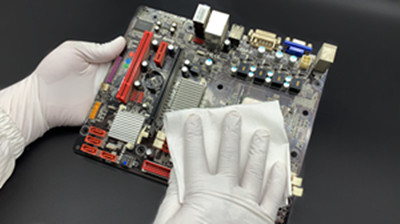Think Before You Use A Wiper
To ensure cleanliness standards are kept within a cleanroom environment, wipes are an essential tool. They need to meet exacting criteria, especially when in a controlled environment.
Any contamination must be eliminated from both the items being manufactured and the manufacturing tools and equipment themselves. Wipes play a fundamental role in this cleanliness control, but are the wipes being used just adding to the contamination problem rather than taking it away? Let’s look at the options and how to choose the right wipe to ensure cleanliness is guaranteed.
Although choosing wipes may appear simple, there is more to it than meets the eye. Wipes come in many sizes, materials, and packaging options, all of which will have an impact on just how clean your cleanroom environment will be after its use.
There are three main categories: nonwoven wipers, woven or knitted wipes and swabs, but whatever the choice, the first consideration should be its absorbency. Dependent on the material makeup of the wipe, absorbency can differ.
The cleanest wipes may not be the most absorbent, and wipes that soak up liquid easily may in return leave unwanted residue behind.
Absorption is usually expressed in millilitres of liquid absorbed by one square meter of the material. However, some wipes work well with cleaning fluids or lacquers but will not absorb water. For example, polyester is petroleum-based so polyester wipes easily absorb gasoline, oils or grease. Cellulose wipes are good for water-based contamination.
It’s important to note that the cleanest wipes may not be the most absorbent, and wipes that soak up liquid easily may in return leave unwanted residue behind.

Options overview
The least expensive option is non-woven. These wipes are generally made from paper or fabric. Paper non-woven wipes are single-use disposables; paper towels for example. There is a range of “hybrid” paper wipes with specially engineered “non-woven fabric”.
This material has the strength, softness, and quality of a woven textile, but is produced at the volumes, speeds and cost of a paper. These lint-free wipes are often found in applications where re-contamination cannot be allowed, such as electronics and medical applications, therefore these are a good option within a cleanroom environment.
Nonwoven cellulose wipes use glues or binders to hold the fibres in place. Binders can amount to 30% by weight of some non-woven products. The most common binder is a water-based latex such as polyacrylate.
Many binders will dissolve when exposed to cleaning fluids, so wipes made with binders are undesirable in critical applications: they will leave adhesives, lint and fibres on the surfaces being cleaned, especially when wet. Most non-woven cellulose wipes are simply insufficiently strong, clean and absorptive to handle anything but the simplest cleaning tasks.
Another option is non-woven wipes made from synthetic fibres like polyester, rayon and polypropylene. These wipes are good for a variety of applications.
For example, textured polypropylene wipes pre-saturated with a d-liomine solvent are ideal for cleaning grease and heavy oils. Polyester non-wovens are good for pharmaceutical companies as they may help to minimise the risk of bioburden by trapping contamination in the wipe.
If cleanroom performance is essential, select knitted synthetic fabrics of polyester or rayon
It’s important that the non-woven wipe is not abrasive in any way, thus eliminating any damage when cleaning. It should be able to endure cleaning without tearing or dissolving when in contact with cleaning fluids leaving residue and particle contamination behind.
Fabric wipes are made from woven or knitted material and come in a range of qualities and prices. The least expensive material is reclaimed fabric, with ”mill end” material following closely behind. Be aware that they can contain permanent press chemicals, stain-resisters and dyes and so can increase contamination issues.
The next level is washed cheesecloth, but it is very hard and stiff, completely unsuited for wiping and may be abrasive. However, once thoroughly washed with special surfactants and detergents, the material becomes very smooth and flexible.
The best quality wipe when it comes to fabric is “washed diaper fabric”. This material is soft, strong and highly absorbent but can be expensive.
If cleanroom performance is essential, select knitted synthetic fabrics of polyester or rayon. These materials are soft, clean, absorbent, and lint-free making them the leading choice if high-quality cleaning results are required.
Swabs
Swabs are effective if cleaning is required in small or hard to reach places as the stick design helps to reach contaminant or absorb liquid. The key to selecting a swab is the design of the head. The materials of construction, plus size and configuration of the head and the handle are the primary factors to consider.
Swabs made from cotton fibre may be the least expensive but it comes at a price with a lot of lint left behind when in use. Reticulated foam makes a good swab for scrubbing but tends to leave particulate residues. The highest quality swabs are made from prewashed knitted fabric.
A key factor when selecting a swab is the materials compatibility. The construction of the swab must be compatible with the cleaning application; if acetone is used on a foam swab, the foam tip will swell and weaken. In applications where acetone must be used, a polyester swab is the better option.
Wipes made from synthetic material like polyester non-woven and knitted fabrics have the biggest range of chemical compatibility. Cellulose material, on the other hand, can easily disintegrate when used with certain cleaning solutions.
Categories
New Blog
Copyright © 2024 Nanan Jiedao Electronic Material Co.,Ltd.. All Rights Reserved. Powered by

IPv6 network supported